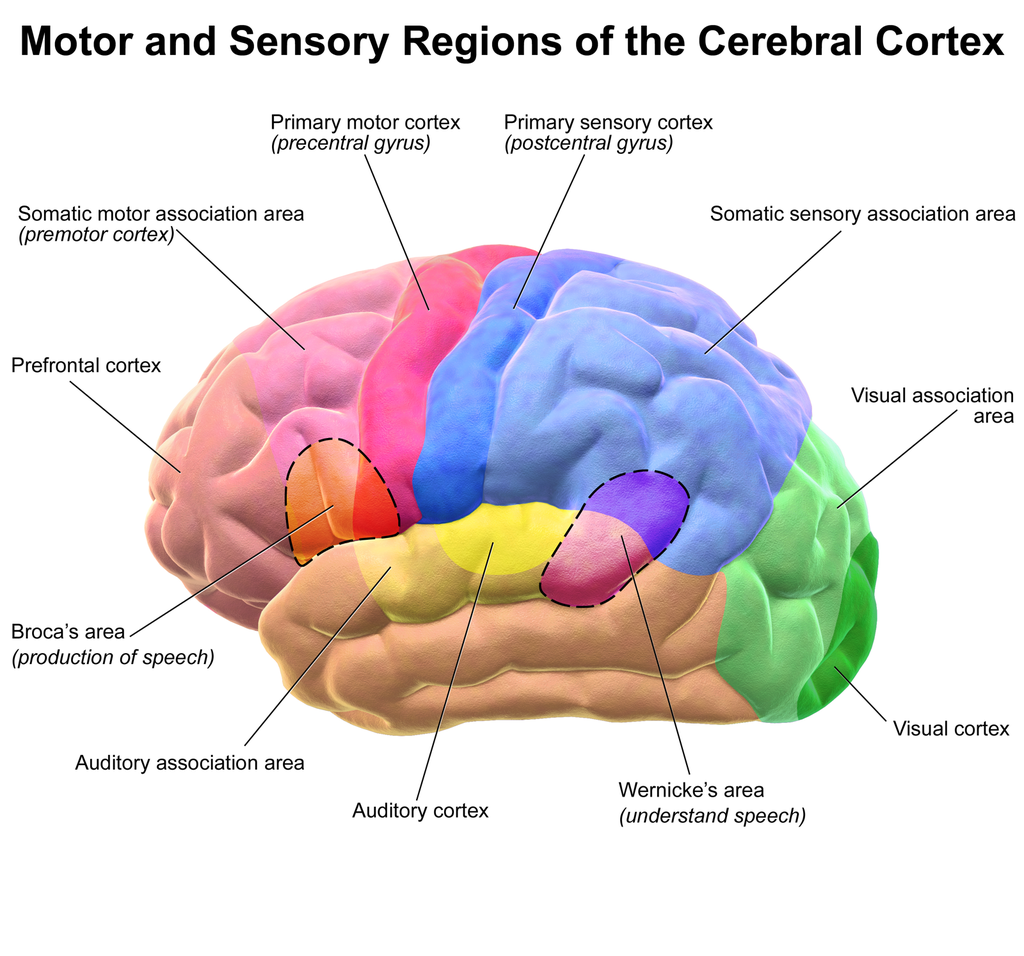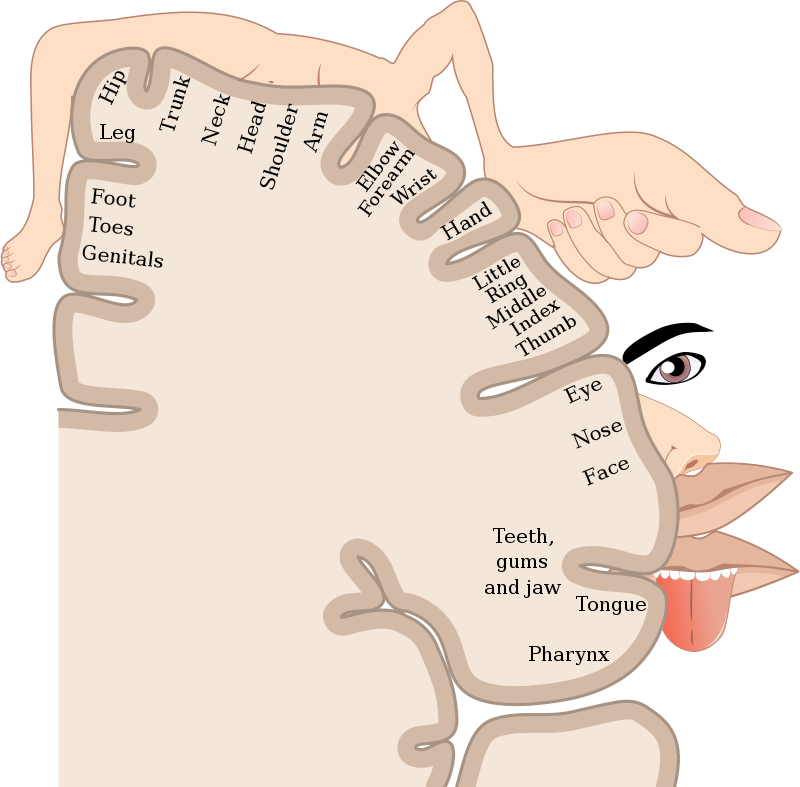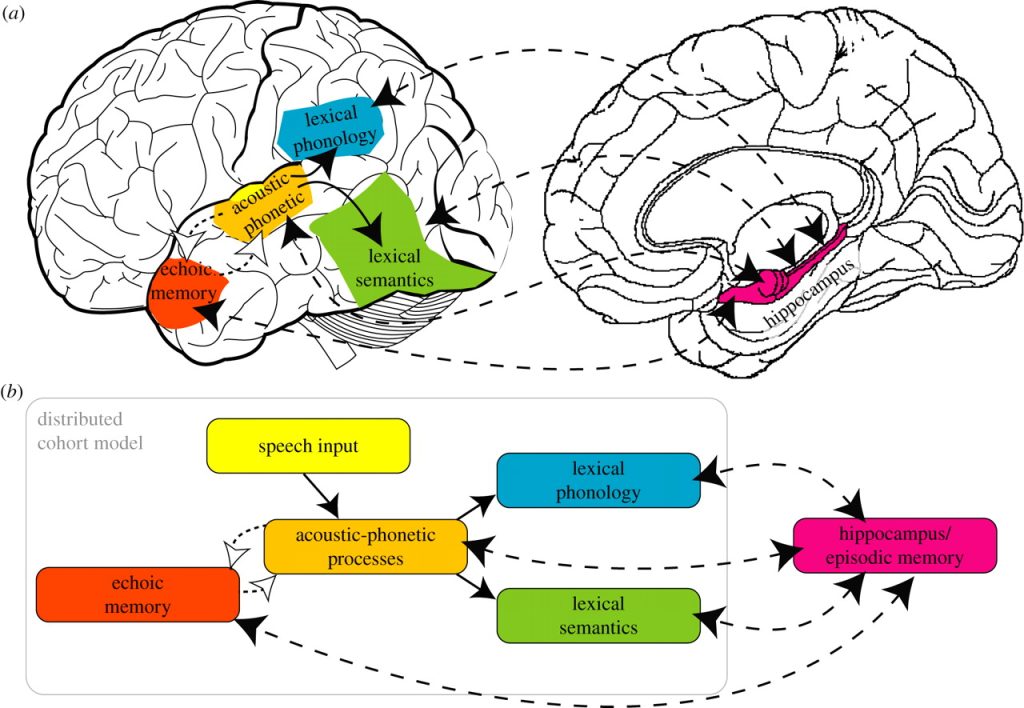Chapter Four: Brain Development from Conception to Age 8
Cerebral Cortex
When you think of the brain, you are probably imagining the outermost layer, but this is only a portion of what makes up the human brain! Of course, that portion is responsible for a lot. The cerebral cortex is represented by the wrinkled layer in this picture of the brain that is primarily responsible for how we interact with the world around us.

These two images both show the lobes of the brain, sometimes with added italicized labels. The ones above give you more details, so that you can have a better sense of what areas are associated with each lobe or what functions the areas have. The ones in italics show the functions of some areas.
Let’s take a look at what each of the lobes of the brain is responsible for.
Occipital Lobe
The occipital lobe is primarily responsible for integrating visual information. It may seem strange that the back of your brain is where information from your eyes is processed, but that is how your brain works! Even stranger still is that the left side of your brain is responsible for processing information from your right eye, and vice versa. Each eyeball has its own visual field from which information is gathered. This information is then sent across the midline of the brain, and into the occipital lobe where it is processed. People who have lost the connection between the two hemispheres of their brain experience significant changes to their visual field, and their ability to talk about what they see!
Parietal Lobe
The parietal lobe runs along the top of the brain just below where a headband might sit. It is where the majority of our sensory input is processed, including our senses of touch, taste, and temperature – all things that are essential for babies as they interact with the world around them!

The parietal lobe includes a specific strip known as the somatosensory cortex. Along this strip, the brain has designated areas that integrate sensory information from specific parts of the body. The name that has been given to this “body map” is the homunculus. As you can see in the image above, the somatosensory cortex is not an exact map, and there are some areas of the body that take up more areas of the brain than others. Remember: each hemisphere of the brain processes information from the opposite side of the body. That means that you have a map on either side of your brain, but each map coordinates information from the other half of your body (Berninger & Richards, 2002).
Look carefully at the brain map; what do you notice about the amount of space given to different body parts?
You probably noticed that your hands and face – especially your lips – take up a lot of space on the somatosensory cortex! Although it makes for a strange looking body map, this is actually very important to understand. Our face and our hands are essential for interacting with the world around us safely and accurately. Have you ever said “let me see that” but meant “Let me hold that in my hand” – that is because we “see” with our hands just as much as with our eyes, in terms of sensory information. Touching things tells us about the weight, texture, and temperature of objects, as well as many other things. Our face is extremely sensitive because our head is where our eyes, ears, and brain all live – and we want to keep those things safe. Other areas of our body, such as our torso, get less neural space simply because this area tends to give us less essential information. It is also worth noticing that parts of the body where we often wear clothes tend to be areas with less sensory nerves. Think about how rarely you notice your clothes on your body compared to noticing a stray hair on your face!
Temporal Lobe
Located along the sides of your head, just above your ears, is your temporal lobe. Unlike the other three lobes of the brain, which obviously connect to one another across the midline of the brain, the temporal lobe appears to be two separate pieces, but is in fact connected through the middle of the brain and crosses the midline deep inside the cerebrum. It does this with the help of specific structures deep inside the brain, including the hippocampus (Berninger & Richards, 2002).
It is not a coincidence that the temporal lobe is situated so close to the ear; it is in this part of the brain that speech and other sounds are processed. The image below shows the pathway of sounds, particularly language, around the temporal lobe. As you can see, once a word is “heard” (the acoustic phonetics) that sound information is split between parts of the temporal lobe that process sound information (lexical phonology) and a part that processes the meaning (lexical semantics) before all of that information makes it way into the hippocampus, where it is attached to memories and emotions, which help us to make sense of what we have heard!

Perhaps the most important aspect of the temporal lobe is the role that it plays in the reception and production of language. As you can see in the brain image above (motor and sensory regions), it is home to Wernicke’s and Broca’s areas – both regions of the brain that specialize in language. These two regions of the brain are located only in the left hemisphere of the temporal lobe, and work together to ensure speech production and comprehension. Wernicke’s area is important in the understanding of speech, while Broca’s area is related to speech production. For more information about each of these areas, check out these short videos about Wernicke’s Wernike’s and Broca’s areas respectively (Berninger & Richards, 2002; Berk, 2017).
Frontal Lobe
The frontal lobe is the last portion of the brain to fully develop, and that is largely because it is so dependent on experience. This is the part of your brain that is the “you.” Located in the front and center of your brain, this is where you make decisions, solve complex problems, interpret social cues, and monitor your own behavior. Although this part of the brain is present from birth, the vast neural networks that make up the frontal lobe are under construction for years – up to 25!
Your frontal lobe is where most of the functions that translate into behaviors originate. While the three lobes of the brain are busy interpreting information from the body and the world, the frontal lobe allows us to make choices about what we do with that information and then to act based on those choices. This is referred to as executive functioning and the development of this part of the brain is essential for success in many aspects of life, including school. A significant piece of executive functioning is attention. Our attention system allows us to focus on a single thing or to divide our attention if necessary. Paying attention often means being able to block out information that is not important, often sensory information in the form of touch, sight, or sound. This means that before the attention system can fully develop, it is necessary for the sensory-information processing lobes in the brain to develop and learn to separate important from unimportant input. In infants, these systems are not yet developed, and it can take years until the attention system is fully functional. In the meantime, children may be easily distracted by sensory information that an adult would not notice, or would be able to ignore.
As you will read later, not all children develop their attention system in the same way. Attention Deficit Disorder is a common diagnosis in childhood, and it is identified when a child has an underdeveloped attention system making it difficult to direct sustained focus on a single task.
The executive function of the frontal lobe also includes our working memory. While our long-term memories are stored deep in the brain, our short term, or work, memory operates in the frontal lobe. This makes sense, since we want our working memory to be able to quickly and efficiently connect with our attention, problem solving, and social processes. That allows us to make decisions and monitor our behavior in the moment.
Buried within the cerebral cortex are several areas that are responsible for managing memory and emotion. Without these parts of the brain, our emotional development would not be possible. The hippocampus, thalamus, and hypothalamus work together to help us remember emotional events and to make sense of the feelings that we have throughout the day. A major piece of early development is learning what feelings are, how to express them appropriately, and how to control them when necessary. The brain plays a significant role in all of this (Berninger & Richards, 2002).
Media Attributions
- Brain Motor and Sensory Regions © :Blausen.com staff (2014). via. Wikimedia Commons is licensed under a CC BY-SA (Attribution ShareAlike) license
- Sensory Homunculus © OpenStax College, via. Wikimedia Commons is licensed under a CC BY-SA (Attribution ShareAlike) license
- Neural and functional organization of systems © Matthew H. Davis and M. Gareth Gaskell, via. Wikimedia Commons is licensed under a CC BY-SA (Attribution ShareAlike) license

